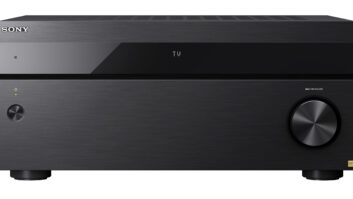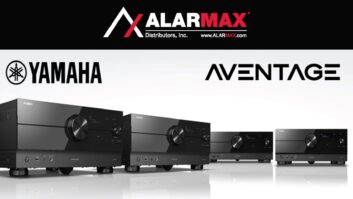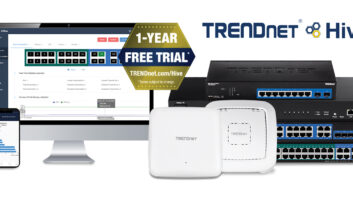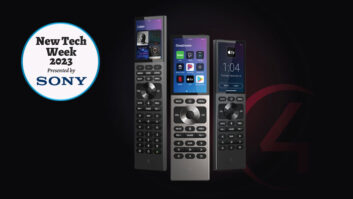Kudos: The Yamaha R-N803 Network Stereo Receiver deftly blends new-school connectivity with old-school cool in a way that other stereo receivers could learn a lot from. Its simple control app and IP driver for advanced control systems combine to create an audio system that can be operated in any number of intuitive ways.
Concerns: Its YPAO room correction system is limited to one measuring position, and tended to have a detrimental effect on imaging, soundstage, and tonal neutrality in rooms that were already pretty well behaved, acoustically speaking.
Take a quick glance at the face of Yamaha’s R-N803 stereo receiver and it’s hard not to form an impression of what you’re in for: old school, no-nonsense, two-channel hi-fi, complete with big, gorgeous tactile knobs and a general lack of fuss or muss. It’s an aesthetic that just screams, “Hook a turntable up to me, wire up a good vintage pair of NS-670 speakers, and get off my lawn.”
Sure, there’s a front-panel USB connection that rather belies this notion, and the fact that the R-N803 has the word “network” in its name is a pretty telling clue that this stereo receiver isn’t all about the old school. But still, even these hints don’t really give a way what a deft mix of throwback and forward-looking the R-N803 actually is.

On the retro side, you’ve got the simple connectivity and straightforward back panel layout you’d expect from a good piece of classic stereo gear. In addition to dedicated CD and phono inputs, it has three line-level RCA ins (and two outs), AM/FM antenna connections, two optical and two coaxial digital inputs, and a really nice set of A- and B-speaker binding posts.
But then there’s the subwoofer output. And the Ethernet port. And the WiFi antenna. And, of course, the MusicCast functionality, which is the bulk of what gives the R-N803 its modern touch.
I won’t dig too deeply into MusicCast again since I’ve done two full reviews of the ecosystem in the past year or so. (You can read the most relevant one at tinyurl.com/RSMusicCast if you just need a refresher). The long and short of it is that MusicCast may never quite rival competitors like HEOS and Sonos in terms of app support and configurability, but if you’re looking for a simple, easy-to-use streaming platform that won’t confuse your Nana or Pop-Pop with too many features or too much fuss, it’s a big winner in my book.
MusicCast is, of course, what gives the R-N803 access to streaming apps like Spotify, Pandora, Napster, XiriusXM, TIDAL, and Deezer. If you have a PC or NAS with DLNA capabilities, you can also access stored music, with support for WAV, FLAC, and AIFF up to 192/24; ALAC up to 96/24; MP3, WMA, and AAC up to 320 kbps; and DSD at 2.8 or 5.6MHz. These files can also be played back from a USB device plugged into the front of the unit.
The R-N803 boasts a clean and beefy 100 watts per channel into 8 ohms, which is plenty enough to drive any speaker I happen to have on hand. I hooked it up several different ways, primarily using it to drive a pair of Paradigm Studio 100 towers full range, but I also cooked up a couple of 2.1 configurations: one relying on a pair of RSL CG3 bookshelves and the company’s Speedwoofer 10S; the other with the Yamaha feeding a pair of GoldenEar Triton One towers, with its LFE output divvied up by way of a y-splitter and run into the Triton Ones’ LFE ins.
At no point with any of these configurations did I come anywhere close to pegging the R-N803’s volume knob, although with the RSL system I did find that I quite liked the effect of nudging its Loudness knob in the clockwise direction for a bit of enhanced grrr and oomph.
Related: Reviewing Meridian Audio’s 857 Reference Two-Channel Power Amplifier
One thing I didn’t notice in any of the documentation for the R-N803 is that it’s supported by a pretty rocking IP driver for Control4 systems. The driver is SDDP (Simple Device Discovery Protocol) enabled, so when I just happened to fire up my Composer Pro programming software for a system update, I saw the Yamaha sitting there in my Discovered Devices tab. A quick drag-and-drop of the driver and a little bit of tinkering to map the connection between the receiver and the only physical source I connected to it (and older Oppo Blu-ray player I use for audio disc playback these days), and I had yet another simple and modern method of controlling the receiver. One that, fortunately, didn’t conflict with the simple app-based control method that I relied on for the bulk of this review.

I mentioned above that I liked to tinker with the Loudness knob on the R-N803 when using it to power smaller speakers. What I didn’t mention is that, no matter what I connected to it, this little stereo powerhouse sounded fantastic. Stereo separation, imaging, and especially the depth of the soundstage were exemplary. And with larger speaker systems, it simply outclassed the Yamaha WXA-50 that I reviewed last year. That’s not a knock on that smaller streaming amp, mind you. For what it is, the WXA-50 is a lovely little overachiever. But when driving a big pair of towers, the beefier power supply and more sophisticated circuit design of the R-N803 aren’t shy about showing off their advantages.
If I have nits to pick with the R-N803, they’re mostly minor and almost all revolve around its implementation of YPAO, Yamaha’s proprietary room correction system. YPAO is one of the few elements of the receiver’s software setup in which you don’t rely on the MusicCast app. You plug the mic in and use the included hard-button remote to navigate the measuring and storing of room acoustics. If one little knob on the front panel isn’t locked to dead center, though, YPAO fails and doesn’t tell you why. It also only measures from one listening position, which is less than ideal.
Honestly, I liked the sound of the R-N803 better with YPAO turned off. In my reasonably well-treated room, it only served to dull the higher frequencies and compact the soundstage a bit. Still, it’s nice to be able to automatically set levels and delays and such at the press of a button. And if you’re installing the receiver in a room that doesn’t behave, you might find that YPAO’s advantages outweigh its sonic weaknesses.
And honestly, I probably wouldn’t even be picking that nit if the R-N803 weren’t such a lovely sounding piece of kit. I’ve listened to a ton of integrated amps and dedicated stereo gear in the past few years. There aren’t many of them that I can confidently say outclass the Yamaha in terms of its openness and transparency, and the ones that do generally sell for many, many times the price of this flexible and intuitive stereo receiver.
Contact information: usa.yamaha.com, 714.522.9105
Product Specs
- Minimum RMS Output Power: 100 W + 100 W (8 ohms, 20 Hz-20 kHz, 0.019% THD)
- Maximum Power (8 ohms, 1 kHz, 10% THD): 145 W + 145 W
- High Dynamic Power/Channel (8/6/4/2 ohms): 140 / 170 / 220 / 290 W
- Signal-to-Noise Ratio (CD): 100 dB (Pure Direct on, 200 mV)
- Audio In / Out: 10 / 2
- Digital Input: Yes (Optical / Coaxial)
- Phono Input: Yes
- USB Input: Yes
- Ethernet: Yes
- DLNA: Version 1.5
- File Format: MP3, WMA, MPEG4 AAC, WAV, FLAC, AIFF, ALAC, DSD
- Wi-Fi: Yes (with Wireless Direct)
- AirPlay: Yes
- Bluetooth: Yes (SBC / AAC)
- Subwoofer Out: Yes
- Control (Trigger) Out: Yes
- Standby Power Consumption: 0.1 W (Network standby on / Wi-Fi connection; 1.8 W)
- Dimensions (W x H x D): 17-1/8″ x 6″ x 15-7/16″ (with antenna up: 17-1/8″ x 8-1/2″ x 15-7/16″)
- Weight: 24.3 lbs.







